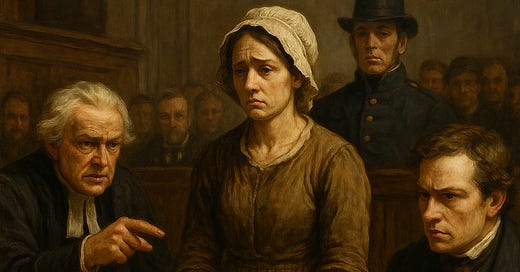In a year of famine, protests, and political unrest, the Highlands of Scotland also witnessed a criminal case so dramatic and revealing that it left its mark not only on public memory but also on the Scottish justice system itself. The protagonist: a woman from Caithness named Barbara Mackay.
Her story weaves together themes of poverty, petty crime, a suspicious coin, and the terrifying shadow of the noose—only to culminate in a rare act of mercy. At a time when women were still being publicly flogged in the streets of Inverness, Barbara’s life dangled between death and reprieve, and her case stirred questions about law, justice, and gender in early 19th-century Scotland.
Caught by a Coin: The Crime at Isauld
In the spring of 1817, Barbara Mackay was implicated in a robbery that took place at a shop in Isauld, a small settlement on the rugged coast of Caithness. According to court reports, she did not commit the actual theft herself. Instead, she stood watch, a lookout for the men who entered the premises and carried out the crime.
But while the men disappeared without a trace, Barbara was caught through an item that connected her directly to the scene: a five-franc coin, part of the stolen money. When she attempted to spend the foreign currency—an unusual possession for a woman of her class—it raised suspicions. She was arrested and confessed to having taken part in the operation, albeit in a minor role. She had not stolen the money, she claimed, but had accepted a share—some silver and copper—for acting as a lookout.
In today’s world, such involvement might have merited probation or a fine. But in 1817 Scotland, the criminal code was harsh and unforgiving, particularly for the poor and for women caught in desperate acts of survival.
The Sentence: Execution for a Watchwoman
Barbara Mackay was tried at the Circuit Court in Inverness and found guilty. Despite the relatively minor nature of her involvement, she was sentenced to be executed by hanging.
The verdict shocked many in the community. This was a woman who had not committed the theft herself. The men responsible—presumably the true masterminds—had escaped, while Barbara, by all accounts a passive participant, was condemned to die.
Why such a severe sentence? Part of the answer lies in the rigidity of the era’s legal structure. The Scottish criminal code at the time was rooted in deterrence and moral example. Execution was not only a punishment—it was a warning to others. And burglary, especially if it took place at night or involved breaking and entering, was categorized among the most serious capital offenses.
Yet, there was a growing tension in Scotland between the harshness of the law and the emerging sensibilities of a society increasingly disturbed by public floggings, executions, and the apparent disproportion between crime and punishment.
Twice Rescued: A Commutation of Justice
Public sympathy and legal advocacy ultimately played a role in Barbara’s fate. After her sentencing, she was twice granted a reprieve—a stay of execution, first for weeks and then for months. This was not an automatic process. It required intervention, petitions, and political or legal discretion from those in authority.
Finally, her sentence was commuted to two years' imprisonment, to be served beginning from the date of her original conviction. While two years in prison was no light punishment, it was, without doubt, a deliverance from death. In a time when transportation to Australia or execution were the norm for even petty crimes, Barbara’s case stood out as a signal of changing attitudes.
But her reprieve didn’t end her notoriety. Newspapers and public discourse of the time returned to her case again and again—sometimes to lament the cruelty of her original sentence, and other times to argue over why the law was not equally lenient in similar cases, such as that of another woman convicted of housebreaking the same year.
Crime and Class in 1817 Scotland
Barbara Mackay’s strange and compelling journey through the justice system raises profound questions. Was she simply a poor woman, caught up in an act of desperation? Was her punishment a product of class, gender, or judicial theater?
Her trial and commutation occurred in a moment when Scotland was already grappling with deep structural inequalities. The Highland Clearances had displaced thousands, food shortages had created hunger and theft, and political reform movements were gathering strength in towns like Inverness, Montrose, and Forres. Against this backdrop, the justice system struggled to appear both powerful and fair—an impossible balance in a deeply unequal society.
And Barbara’s story also reflects something very human: the use of a single coin to unravel a whole narrative. That small, foreign piece of silver became both a symbol of guilt and a key to survival. The system found her culpable—but the public found her sympathetic.
In the end, Barbara Mackay did not hang. But the fear, shame, and delay of justice lingered with her far longer than the newspapers did.
Adapted From: Barron, J. (1903). The Northern Highlands in the nineteenth century: Newspaper index and annals (Vol. 1). Inverness: R. Carruthers & Sons





